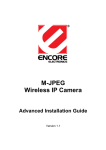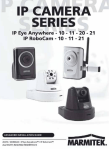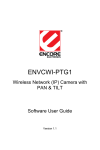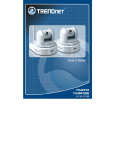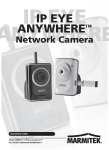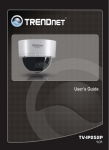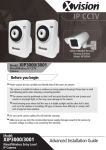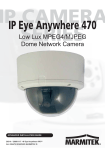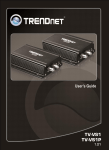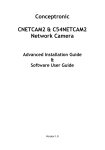Download Encore ENVCWI-PTG1 - ADVANCED Installation guide
Transcript
ENVCWI-PTG1 Wireless Network (IP) Camera with PAN & TILT Advanced Installation Guide Version 1.1 Regulatory notes and statements Wireless LAN, Health and Authorization for use Radio frequency electromagnetic energy is emitted from Wireless LAN devices. The energy levels of these emissions however are far much less than the electromagnetic energy emissions from wireless devices like for example mobile phones. Wireless LAN devices are safe for use frequency safety standards and recommendations. The use of Wireless LAN devices may be restricted in some situations or environments for example: •On board of airplanes, or •In an explosive environment, or •In case the interference risk to other devices or services is perceived or identified as harmful In case the policy regarding the use of Wireless LAN devices in specific organizations or environments (e.g. airports, hospitals, chemical/oil/gas industrial plants, private buildings etc.) is not clear, please ask for authorization to use these devices prior to operating the equipment. Regulatory Information/disclaimers Installation and use of this Wireless LAN device must be in strict accordance with the instructions included in the user documentation provided with the product. Any changes or modifications made to this device that are not expressly approved by the manufacturer may void the user’s authority to operate the equipment. The Manufacturer is not responsible for any radio or television interference caused by unauthorized modification of this device, of the substitution or attachment. Manufacturer and its authorized resellers or distributors will assume no liability for any damage or violation of government regulations arising from failing to comply with these guidelines. USA-FCC (Federal Communications Commission) statement This device complies with Part 15 of FCC Rules. Operation is subject to the following two conditions: 1. This device may not cause interference, and 2. This device must accept any interference, including interference that may cause undesired operation of this device. -1- FCC Radio Frequency Exposure statement This Wireless LAN radio device has been evaluated under FCC Bulletin OET 65 and found compliant to the requirements as set forth in CFR 47 Sections 2.1091, 2.1093, and 15.247 (b) (4) addressing RF Exposure from radio frequency devices. The radiated output power of this Wireless LAN device is far below the FCC radio frequency exposure limits. Nevertheless, this device shall be used in such a manner that the potential for human contact during normal operation is minimized. When nearby persons has to be kept to ensure RF exposure compliance, in order to comply with RF exposure limits established in the ANSI C95.1 standards, the distance between the antennas and the user should not be less than 20 cm. FCC Interference Statement This equipment has been tested and found to comply with the limits for a Class B digital device, pursuant to Part 15 of the FCC Rules. These limits are designed to provide reasonable protection against harmful interference in a residential installation. This equipment generates, uses, and can radiate radio frequency energy. If not installed and used in accordance with the instructions, it may cause harmful interference to radio communications. However, there is no guarantee that interference will not occur in a particular installation. If this equipment does cause harmful interference to radio or television reception, which can be determined by turning the equipment off and on, the user is encouraged to try and correct the interference by one or more of the following measures: 1. Reorient or relocate the receiving antenna. 2. Increase the distance between the equipment and the receiver. 3. Connect the equipment to an outlet on a circuit different from that to which the receiver is connected. 4. Consult the dealer or an experienced radio/TV technician for help. Export restrictions This product or software contains encryption code that may not be exported or transferred from the US of Canada without an approved US Department of Commerce export license. -2- Safety Information Your device contains a low power transmitter. When device is transmitted it sends out radio frequency (RF) signal. CAUTION: To maintain compliance with FCC’s RF exposure guidelines, this equipment should be installed and operated with minimum distance 20cm between the radiator and your body. Use on the supplied antenna. Unauthorized antenna, modification, or attachments could damage the transmitter and may violate FCC regulations. The antenna(s) used for this transmitter must be installed to provide a separation distance of at least 20 cm from all persons and must not be colocated or operating in conjunction with any other antenna or transmitter. CE Mark Warning This is a Class B product. In a domestic environment, this product may cause radio interference, in which case the user may be required to take adequate measures. Protection requirements for health and safety – Article 3.1a Testing for electric safety according to EN 60950 has been conducted. These are considered relevant and sufficient. Protection requirements for electromagnetic compatibility (EMC) – Article 3.1b Testing for electromagnetic compatibility according to EN 301 489-1, EN 301 489-17 and EN 55024 has been conducted. These are considered relevant and sufficient. Effective use of the radio spectrum – Article 3.2 Testing for radio test suites according to EN 300 328 has been conducted. These are considered relevant and sufficient. CE in which Countries where the product may be used freely: Germany, UK, Italy, Spain, Belgium, Netherlands, Portugal, Greece, Ireland, Denmark, Luxembourg, Austria, Finland, Sweden, Norway and Iceland. France: except the channel 10 through 13, law prohibits the use of other channels. Caution The Federal Communication Commission warns the user that changes or modifications to the device not expressly approved by the party responsible for compliance could void the user’s authority to operate the equipment. -3- Copyright The company has an on-going policy of upgrading its products and it may be possible that information in this document is not up-to-date. Please check with your local distributors for the latest information. The contents of this publication may not be reproduced in any part or as a whole, stored, transcribed in an information retrieval system, translated into any language, or transmitted in any form or by any means, mechanical, magnetic, electronic, optical, photocopying, manual, or otherwise, without the prior written permission or consent from the company. Trademarks All products, companies and brand names are trademarks or registered trademarks of their respective companies. They are used for identification purpose only. Specifications are subject to be changed without prior notice. -4- P REFACE Thank you for purchasing the Wireless Network (IP) Camera with PAN & TILT, a powerful wireless network camera with the 2-way audio function which provides the high-quality image and on-the-spot audio via the Internet connection. The camera’s pan/tilt functions allow you to control the camera to monitor everywhere remotely. Through the GPIO connectors, the camera can attach a variety of external devices for your specific purposes. The camera can be installed as a standalone system within your application environment easily and quickly, and supports remote management function so that you can access and control it using a Web browser on your PC. This Advanced Installation Guide provides you with the instructions and illustrations on how to use your camera, which includes: Chapter 1 Introduction to Your Camera describes the features of the camera. You will also know the components and functions of the camera. Chapter 2 Hardware Installation helps you install the camera according to your application environment. You can use this camera at home, at work, at any where you want. Chapter 3 Accessing the Camera lets you start using your camera without problem. The camera can be set up easily and work within your network environment instantly. Chapter 4 Configuring the Camera guides you through the configuration of the camera using the Web browser on your PC. Chapter 5 Appendix provides the specification of the camera and some useful information for using your camera. NOTE The illustrations and configuration values in this guide are for reference only. The actual settings depend on your practical application of the camera. -5- Contents Preface................................................................................................5 Chapter 1 Introduction To Your Camera.............................................7 1.1 Checking the Package Contents...........................................7 1.2 Getting to Know Your Camera ..............................................8 1.3 Features and Benefits .........................................................10 1.4 System Requirement...........................................................12 Chapter 2 Hardware Installation .......................................................13 2.1 Installing the Wall Mount Kit................................................13 2.2 Connecting the Camera to LAN/WLAN...............................14 2.3 Applications of the Camera .................................................15 Chapter 3 Accessing The Camera....................................................16 3.1 Using IPFinder ....................................................................16 3.2 Accessing to the Camera ....................................................17 3.3 Configuring the IP Address of the PC .................................21 Chapter 4 Configuring The Camera..................................................22 4.1 Using the Web Configuration ..............................................22 4.2 Using Smart Wizard ............................................................23 4.3 Basic Setup .........................................................................26 4.4 Network Settings .................................................................30 4.5 Pan/Tilt Settings ..................................................................37 4.6 Setting up Video & Audio ....................................................38 4.7 Event Server Configuration .................................................42 4.8 Motion Detect ......................................................................45 4.9 Event Config........................................................................46 4.10 Tools ...................................................................................51 4.11 Information ..........................................................................53 Appendix...........................................................................................54 A.1 Specification........................................................................54 A.2 GPIO Terminal Application..................................................56 A.3 Glossary of Terms...............................................................57 -6- C HAPTER 1 I NTRODUCTION T O Y OUR C AMERA 1.1 Checking the Package Contents Check the items contained in the package carefully. You should have the following: One Wireless Network (IP) Camera with PAN & TILT. One AC Power Adapter. One External Detachable Antenna One Wall Mount Kit. One GPIO Connector One Ethernet Cable (RJ-45 type). One Installation CD-ROM. One Quick Installation Guide. NOTE Once any item contained is damaged or missing, contact the authorized dealer of your locale. If you have any problem on the product(s), please contact your local authorized dealer or check our web site http://www.encore-usa.com for support. -7- 1.2 Getting to Know Your Camera Antenna Lens Assembly Power LED indicates the camera is powered on with the steady amber light. Link LED indicates the camera’s network connectivity with the flashing green light. Internal Microphone allows the camera to receive sound and voice. Front View -8- Ethernet Cable Connector connects the network cable, which supports the NWay protocol so that the camera can detect the network speed automatically. External Antenna Connector connects the external antenna. DC Power Connector connects the AC power adapter, in order to supply power to the camera. Audio-out Connector connects an external active speaker. GPIO Connectors is used to connect the external devices. Reset Button will restart the camera when it is pressed quickly; when it is pressed and held for five seconds, the camera will resume the factory default settings. Rear View -9- 1.3 Features and Benefits MJPEG codec Supported The camera provides you with excellent images by the MJPEG codec technology, allowing you to adjust image size and quality, and bit rate according to the networking environment. 2-way Audio Capability The built-in microphone of the camera provides on-the-spot audio via the Internet, allowing you to monitor the on-site voice. In addition, you can connect an external speaker to the camera to speak through the camera. Optimal Viewing With the pan/tile functions, you can easily monitor everywhere via the camera by moving the camera lens to the left/right (165/165 degrees) or up/down (90/15 degrees). In addition, you can assign up to eight positions for the camera, enabling you to move the camera lens to the desired position quickly. I/O Connectors Provided The camera provides the I/O connectors on the rear panel (IN/OUT), which provide the physical interface to send and receive digital signals to a variety of external alarm devices. You can connect a special featured device, and then configure the settings and control the device from the GPIO Trigger window of Web Configuration. Remote Control Supported By using a standard Web browser or the bundled UltraView software application, the administrator can easily change the configuration of the camera via Intranet or Internet. In addition, the camera can be upgraded remotely when a new firmware is available. The users are also allowed to monitor the image and take snapshots via the network. - 10 - Multiple Platforms Supported The camera supports multiple network protocols, including TCP/IP, SMTP e-mail, HTTP, and other Internet related protocols. Therefore, you can use the camera in a mixed operating system environment, such as Windows 2000 and Windows XP. Multiple Applications Supported Through the remote access technology, you can use the cameras to monitor various objects and places for your own purposes. For example, babies at home, patients in the hospital, offices and banks, and more. The camera can capture both still images and video clips, so that you can keep the archives and restore them at any time. - 11 - 1.4 System Requirement Networking LAN: 10Base-T Ethernet or 100Base-TX Fast Ethernet. WLAN: IEEE 802.11g/b compliant wireless interface. Accessing the Camera using Web Browser Platform: Microsoft® Windows® 2000/XP/Vista CPU: Intel Pentium III 350MHz or above RAM: 128MB Resolution: 800x600 or above User Interface: Microsoft® Internet Explorer 6.0 or above Apple Safari 2 or above Mozilla Firefox 2.00 or above Accessing the Camera using UltraView Platform: Microsoft® Windows® 2000/XP/Vista Hardware Requirement: 1 camera connected: Intel Pentium III 800MHz; 512MB RAM 2 ~ 4 cameras connected: Intel Pentium 4 1.3GHz; 512MB RAM 5 ~ 8 cameras connected: Intel Pentium 4 2.4GHz; 1GB RAM 9 ~ 16 cameras connected: Intel Pentium 4 3.4GHz; 2GB RAM Resolution: 1024x768 or above NOTE If you connect multiple cameras to monitor various places simultaneously, you are recommended to use a computer with higher performance. - 12 - C HAPTER 2 H ARDWARE I NSTALLATION 2.1 Installing the Wall Mount Kit The camera comes with a Wall Mount Kit, which allows you to place your camera anywhere by mounting the camera through the three screw holes located in the base of the Wall Mount Kit. Screw Wall Mount Kit Screw Screw - 13 - 2.2 Connecting the Camera to LAN/WLAN Use the provided Ethernet cable to connect the camera to your local area network (LAN). When you connect the AC power adapter, the camera is powered on automatically. You can verify the power status from the Power LED on the front panel of the camera. Once connected, the Link LED starts flashing green light and the camera is on standby and ready for use now. Connecting the Ethernet Cable If you use a wireless network in your application environment, you need to attach the included external antenna to the camera. When the camera is powered on, the camera will automatically search any access point with “default” SSID. Connecting the External Antenna NOTE If the camera cannot connect to your wireless network, you need to install the camera in LAN and proceed with WLAN settings. - 14 - 2.3 Applications of the Camera The camera can be applied in multiple applications, including: Monitor local and remote places and objects via Internet or Intranet. Capture still images and video clips remotely. Upload images or send email messages with the still images attached. The following diagram explains one of the typical applications for your camera and provides a basic example for installing the camera. * * * Please enclose by waterproof housing when using in outdoor Home Applications - 15 - C HAPTER 3 A CCESSING T HE C AMERA 3.1 Using IPFinder The camera comes with a convenient utility, IPFinder, which is included in the Installation CD-ROM, allowing you to search the camera on your network easily. 1. Insert the Installation CD-ROM into your computer’s CD-ROM drive to initiate the Auto-Run program. 2. Click the IPFinder item to launch the utility. The control panel will appear as below. Display the connected camera(s). Double click to link the Camera. Click About to get the Version information of IPFinder. Click Link to connect the selected camera. Click Change IP to modify the IP address of the selected camera. Click Search to find the IP address of the connected camera(s). Click Exit to close the utility. 3. Once you get the IP address of the camera, launch the Web browser through the Link button or use UltraView software to access your camera. - 16 - 3.2 Accessing to the Camera Whenever you want to access the camera: 1. Connect your camera to the network (or the PC directly). 2. Since the default configuration of the camera is DHCP mode enabled, you are recommended to launch IPFinder to search the IP address that is assigned to the camera by the DHCP server, and then click Link to access the camera via the Web browser. 3. When the login window appears, enter the default User name (admin) and password (admin) and press OK to access to the main screen of the camera’s Web Configuration. Enter the User name and Password. NOTE If you are initially access to the camera, you will be ask to install a new plug-in for the camera. Permission request depends on the Internet security settings of your computer. Click Yes to proceed. - 17 - After you login into the Web Configuration of the camera, the main page will appear as below: Zoom In Buttons Live View/Setup Switch Nightmode Button Camera Information Pan/Tilt Buttons Live View Image Function Buttons The main page of the Web Configuration provides you with many useful information and functions, including: Camera Information – Displays the camera’s location and the current date & time. The information can be modified in the Web Configuration. Live View Image – Displays the real-time image of the connected camera. Move your mouse to the Live View area and click on anywhere, the camera lens will then move to the position where you clicked to display it in the central part of Live View area. When you enlarge the Live View by clicking the Zoom In buttons (2x or 3x), you can move the displayed image by right-clicking your mouse on the Live View area. The position - 18 - where you right-clicked will be displayed in the central part of Live View area. Zoom In Buttons – Click the buttons to zoom in the live view image by 1x, 2x, and 3x. Nightmode Button – Click the button to enable the “nightshot mode” to deliver clearer images in the dark environment. However, this will reduce the frame rate of video setting. Live View/Setup Switch – Click Setup to configure the camera. For details, see Chapter 4. Pan/Tilt Buttons – Provides the buttons to control the camera lens: Left/Right/Up/Down/Home buttons allow you to move the camera lens position. Clicking the Home button will move the camera lens to the assigned home position. Up Home Left Right Down Auto Patrol button controls the camera to automatically scan the preset positions once. Click Stop to stop patrolling. Click the Number button (1~8) to move the camera lens to the preset position immediately. To set up the preset positions, move the camera lens by clicking the Left/Right/Up/Down buttons to the desired position first, then select the number (1~8) from the pulldown list and click the Apply button. You can enter a descriptive name for the assigned position in the text box to identify it easily. - 19 - Function Buttons – Use these buttons to control the audio, video, and trigger functions. Manual Record allows you to record and save a video clip. Snapshot allows you to capture and save a still image. Browse allows you to assign the destination folder to store the video clips and still images. Talk allows you to speak out through the camera. Please note only one user is allowed to use this function at a time. Listen allows you to receive the on-site sound and voice from the camera. Trigger Out allows you to trigger on/off the GPIO output manually. NOTE If your PC use Microsoft Vista platform, maybe you can’t find these recorded files what stored by Snapshot or Manual Record. You need to disable the protected mode of Security in the IE Browser. Please follow as below Steps: 1. Open IE Browser 2. Select Tools Internet Options 3. Select Security 4. Disable the “Enable Protected Mode” then press OK - 20 - 3.3 Configuring the IP Address of the PC If you are failed to access to the camera, please check the IP address of your computer. When you connect the camera to your computer directly to proceed with configuration of the camera, you need to set up the IP addresses to be in the same segment for the two devices to communicate. 1. On your computer, click Start > Control Panel to open the Control Panel window. 2. Double-click Network Connection to open the Network Connection window. 3. Right-click Local Area Connection and then click Properties from the shortcut menu. 4. When the Local Area Connection Properties window appears, select the General tab. 5. Select Internet Protocol [TCP/IP] and then click Properties to bring up the Internet Protocol [TCP/IP] Properties window. 6. To configure a fixed IP address that is within the segment of the camera, select the Use the following IP address option. Then, enter an IP address into the empty field. The suggested IP address is 192.168.0.x (x is 1~254 except 30), and the suggested Subnet mask is 255.255.255.0. 7. When you finished the setting, click OK. - 21 - C HAPTER 4 C ONFIGURING T HE C AMERA 4.1 Using the Web Configuration You can access and manage the camera through the Web browser and the provided software application UltraView. This chapter describes the Web Configuration, and guides you through the configuration of the camera by using the Web browser. To configure the camera, click Setup on the main page of Web Configuration. The Web Configuration will start from the Basic page. The Web Configuration contains the settings that are required for the camera in the left menu bar, including Smart Wizard, Basic, Network, Pan/Tilt, Video/Audio, Event Server, Motion detect, Event Config, Tools, and Information. - 22 - 4.2 Using Smart Wizard The camera’s Smart Wizard lets you configure your camera easily and quickly. The wizard will guide you through the necessary settings with detailed instructions on each step. To start the wizard, click Smart Wizard in the left menu bar. Step 1. Camera Settings Enter the name for the camera and place. Enter the administrator password set. Step 2. IP Settings Select the IP setting according to your network: DHCP, Static IP, or PPPoE. - 23 - Step 3. Email Settings Enter the required information to be able to send email with image. Step 4. Wireless Networking Complete the required settings for wireless networking. - 24 - Step 5. Confirm Settings This step shows the configuration of your camera. When you confirm the settings, click Apply to finish the wizard and reboot the camera. Otherwise, click Prev to go back to the previous step(s) and change the settings. Or, click Cancel to end the wizard and discard the changes. - 25 - 4.3 Basic Setup The Basic menu contains three sub-menus that provide the system settings for the camera, such as the Camera Name, Location, Date & Time, and User management. Basic >> System Basic - Camera Name: Enter a descriptive name for the camera. - Location: Enter a descriptive name for the location used by the camera. Indication LED This item allows you to set the LED illumination as desired. There are two options: Normal and OFF. - 26 - Basic >> Date & Time - TimeZone: Select the proper time zone for the region from the pull-down menu. - Synchronize with PC: Select this option and the date & time settings of the camera will be synchronized with the connected computer. - Synchronize with NTP Server: Select this option and the time will be synchronized with the NTP Server. You need to enter the IP address of the server and select the update interval in the following two boxes. - Manual: Select this option to set the date and time manually. - 27 - Basic >> User Administrator To prevent unauthorized access to the camera’s Web Configuration, you are strongly recommended to change the default administrator password. Type the administrator password twice to confirm and set the password. General User - User Name: Enter the user’s name you want to add to use the camera. - Password: Enter the password for the new user. When you are finished, click Add/Modify to add the new user to the camera. To modify the user’s information, select the one you want to modify from UserList and click Add/Modify. - 28 - - UserList: Display the existing users of the camera. To delete a user, select the one you want to delete and click Delete. Guest - User Name: Enter the guest’s name you want to add to use the camera. - Password: Enter the password for the new guest. - UserList: Display the existing guests of the camera. To delete a user, select the one you want to delete and click Delete. NOTE The “General User” can access the camera and control the Function buttons of the camera’s Web Configuration. The “Guest” can only view the live view image from the main page of the Web Configuration while accessing the camera. Only the “Administrator” is allowed to configure the camera through the Web Configuration. - 29 - 4.4 Network Settings The Network menu contains three sub-menus that provide the network settings for the camera, such as the IP Setting, DDNS Setting, IP Filter, and Wireless network. Network >> Network IP Setting - 30 - This item allows you to select the IP address mode and set up the related configuration. The default setting is DHCP mode enabled. - DHCP: Select this option when your network uses the DHCP server. When the camera starts up, it will be assigned an IP address from the DHCP server automatically. - Static IP: Select this option to assign the IP address for the camera directly. You can use IPFinder to obtain the related setting values. IP Enter the IP address of the camera. The default setting is 192.168.0.30. Subnet Mask Enter the Subnet Mask of the camera. The default setting is 255.255.255.0. Default Gateway Enter the Default Gateway of the camera. The default setting is 192.168.0.1. Primary/ Secondary DNS The DNS (Domain Name System) translates domain names into IP addresses. Enter the Primary DNS and Secondary DNS that are provided by your ISP. - PPPoE: Select this option when you use a direct connection via the ADSL modem. You should have a PPPoE account from your Internet service provider. Enter the User Name and Password. The camera will get an IP address from the ISP as starting up. NOTE Once the camera get an IP address from the ISP as starting up, it automatically sends a notification email to you. Therefore, when you select PPPoE as your connecting type, you have to set up the email or DDNS configuration in advance. DDNS Setting - 31 - With the Dynamic DNS feature, you can assign a fixed host and domain name to a dynamic Internet IP address. Select the Enable option to enable this feature. Then, select the DDNS Provider from the pull-down list and enter the required information in the Host Name, User Name, and Password boxes. Please note that you have to sign up for DDNS service with the service provider first. UPnP The camera supports UPnP (Universal Plug and Play), which is a set of computer network protocols that enable the device-todevice interoperability. In addition, it supports port auto mapping function so that you can access the camera if it is behind an NAT router or firewall. Select the Enable option to enable this feature. Ports Number - HTTP Port: The default HTTP port is 80. - 32 - Network >> IP Filter The IP Filter setting allows the administrator of the camera to limit the users within a certain range of IP addresses to access the camera. Start/End IP Address Assign a range of IP addresses that are not allowed to access the camera by entering the Start IP address and End IP address. When you finish the setting, click Add to save the range setting. You can repeat the action to assign multiple ranges for the camera. For example, when you enter 192.168.0.50 in Start IP Address and 192.168.0.80 in End IP Address, the user whose IP address located within 192.168.0.50 ~ 192.168.0.80 will not be allowed to access the camera. - 33 - Deny IP List The list displays the range setting(s) of IP addresses that are not allowed to access the camera. To clear the setting, select a range of IP addresses from the list and click Delete. Network >> Wireless Setting The camera supports WLAN while you use the wireless network. Select the Enable option to enable this feature. - Network ID (SSID): Keep the default setting of this option to connect the camera to any access point under the infrastructure network mode. To connect the camera to a - 34 - specified access point, set a SSID for the camera to correspond with the access point’s ESS-ID. To connect the camera to an Ad-Hoc wireless workgroup, set the same wireless channel and SSID to match with the computer’s configuration. Click Site Survey to display the available wireless networks, so that you can easily connect to one of the listed wireless networks. List of searching results - Wireless Mode: Select the type of wireless communication for the camera: Infrastructure or Ad-Hoc. - Channel: Select the appropriate channel from the list. - Authentication: Select the authentication method to secure the camera from being used by unauthorized user: Open, Shared-key, WPA-PSK, and WPA2-PSK. The following table explains the four options: Open The default setting of Authentication mode, which communicates the key across the network. Shared-key Allow communication only with other devices with identical WEP settings. WPA-PSK/ WPA2-PSK WPA-PSK/WPA2-PSK is specially designed for the users who do not have access to network - 35 - authentication servers. The user has to manually enter the starting password in their access point or gateway, as well as in each PC on the wireless network. If you select Open or Shared-key as the Authentication mode, you need to complete the following settings: Encryption: Select the WEP option to enable the data encryption feature to secure the camera within the wireless network. Format: Once you enable the Encryption feature, you need to determine the encryption format by selecting ASCII or HEX. ASCII format causes each character you type to be interpreted as an eight-bit value. Hex format causes each pair of characters you type to be interpreted as an eight-bit value in hexadecimal (base 16) notation. Key Length: Select the WEP key length you want to use: 64 bits or 128 bits. WEP Key 1/2/3/4: Enter the WEP key(s) in the following boxes. If you select WPA-PSK or WPA2-PSK as the Authentication mode, you need to complete the following settings: Encryption: Select TKIP or AES. TKIP (Temporal Key Integrity Protocol) changes the temporal key every 10,000 packets to insure much greater security than the standard WEP security. AES (Advanced Encryption Standard) is used to ensure the highest degree of security and authenticity for digital information. Pre-Shared Key: This is used to identify each other in the network. Enter the name in the box, and this name must match the Pre-shared key value in the remote device. - 36 - 4.5 Pan/Tilt Settings The Pan/Tilt menu allows you to configure the pan/tilt functions of the camera. Pan/Tilt >> Pan & Tilt Settings - Pan/Tilt Calibration: Click Calibration to calibrate the position of the camera lens. - Pan Steps: Set the changing range (1~20 degrees) when you click the Left/Right button. - Tilt Steps: Set the changing range (1~20 degrees) when you click the Up/Down button. - Auto Patrol Stay Time: Set the stay time (1~999 seconds) of each preset positions when the camera is patrolling. - 37 - 4.6 Setting up Video & Audio The Video & Audio menu contains three sub-menus that provide the video and audio settings for the camera. Video & Audio >> Camera Image Setting - Brightness: Adjust the brightness level from 0 ~ 100. - Contrast: Adjust the contrast level from 0 ~ 100. - Saturation: Adjust the colors level from 0 ~ 100. - 38 - Click Default to restore the default settings of the three options above. - Mirror: Select the Horizontal option to mirror the image horizontally. Select the Vertical option to mirror the image vertically. - Light Frequency: Select the proper power frequency according to the camera’s location: 50Hz, 60Hz, or Outdoor. Overlay Setting - Includes Date & Time: Select this option to display the date & time stamp on the live view image. - Enable Opaque: Select this option to set a black background to the displayed date & time stamp. - 39 - Video & Audio >> Video MJPEG - Video Resolution: Select the desired video resolution from the three formats: VGA, QVGA and QQVGA. The higher setting (VGA) obtains better video quality while it uses more resource within your network. - Video Quality: Select the desired image quality from five levels: Lowest, Low, Medium, High, and Highest. - Frame Rate: Select Auto or a proper setting depending on your network status. - 40 - Video & Audio >> Audio Camera Microphone In Select the Enable option to enable the camera’s audio function, so that you can receive the on-site sound and voice from the camera. Camera Speaker Out Select the Enable option to enable the camera’s external speaker function, so that the connected speaker can play the sound and voice through the camera. - Volume: Set the speaker’s volume. - 41 - 4.7 Event Server Configuration The Event Server menu contains two sub-menus that allow you to upload images to FTP, send emails that include still images, and store the images to a NAS system. When you complete the required settings for FTP or Email, click Test to test the related configuration is correct or not. Once the camera connects to the server successfully, click Apply. Event Server Setting>> FTP - Host Address: Enter the IP address of the target FTP server. - Port Number: Enter the port number used for the FTP server. - User Name: Enter the user name to login into the FTP server. - Password: Enter the password to login into the FTP server. - 42 - - Directory Path: Enter the destination folder for uploading the images. For example, /Test/. - Passive Mode: Select the Enable option to enable passive mode. Event Server Setting >> Email - SMTP Server Address: Enter the mail server address. For example, mymail.com. - Sender Email Address: Enter the email address of the user who will send the email. For example, [email protected]. - Sender User Name: Enter the user name to login the mail server. - 43 - - Sender Password: Enter the password to login the mail server. - Receiver #1 Email Address: Enter the first email address of the user who will receive the email. - Receiver #2 Email Address: Enter the second email address of the user who will receive the email. - 44 - 4.8 Motion Detect The Motion Detect menu contains the command and option that allow you to enable and set up the motion detection feature of the camera. The camera provides two detecting areas. To enable the detecting area, select Window 1 or 2 from the pulldown list, and then select Enable. When the detecting area is enabled, you can use the mouse to move the detecting area and change the area coverage. - Name: Assign a name to the detecting area. - Threshold: Move the slide bar to adjust the level for detecting motion to record video. NOTE Sliding the Threshold bar to the right will decrease the sensitivity of motion detection; sliding the Threshold bar to the left will increase the sensitivity of motion detection - 45 - 4.9 Event Config The Event Config menu contains five sub-menus that provide the commands to configure event profiles. Event Configuration >> General Setting - Snapshot/Recording Subfolder: You can assign a descriptive name for the subfolder to save the captured image/video files. Otherwise, leave this option blank to use the default setting. - GPIO Trigger Out Retention Time Per Event: Limit the retention time of the GPIO Trigger Out function. - 46 - Event Configuration >> Arrange Schedule Profile This sub-menu displays the scheduled profile(s). To customize the profile, click Add and then enter a descriptive name for the profile in the prompt dialog window. After entering the profile name, click OK and the profile is added to the Schedule Profiles list. To delete the profile, select the profile in the list and click Delete. - Profile Name: Display the profile name that you select in the Schedule Profiles list. - Weekdays: Select the weekday(s) that you want to separately assign in the schedule profile. The weekday that has been assigned will be displayed with green color. - Time List: Display the time period that you have assigned within the selected weekday. To assign the same time period to every weekday, click Add this to all weekdays; click Delete this from all weekdays to remove the selected time period from every weekday. Click Delete to remove the selected time period. - Start/End Time: Enter the start and end time and then click Add to assign a time period within in the selected weekday. - 47 - Event Configuration >> Motion Detect Trigger Select the Enable option to enable the motion detect trigger function of the camera, so that you can set Trigger Out function or send captured images within the detecting area to the FTP server or email receiver. You have to configure corresponding settings, such as FTP server and email server, to enable this feature. - Schedule Profile: Select a schedule profile from the pull-down list. - Action: Set the Trigger Out function or select the destination of the captured images: Send Email or FTP Upload. - 48 - Event Configuration >> Schedule Trigger You can separately configure the schedule for trigger function of the camera by Email or FTP. Select the Enable option on each item, and then select a Schedule Profile from the pull-down list and set the Interval time. Email/FTP Schedule - Schedule Profile: Select a schedule profile from the pull-down list. - Interval: Enter a number in this box to setup the time (in second) to send Email or upload to FTP regularly. - 49 - Event Configuration >> GPIO Trigger Select the Enable option to enable the GPIO trigger function of the camera, so that you can set Trigger Out function or send captured images within the detecting area to the FTP server or email receiver. You have to configure corresponding settings, such as FTP server and email server, to enable this feature. - Schedule Profile: Select a schedule profile from the pull-down list. - Action: Set the Trigger Out function or select the destination of the captured images: Send Email or FTP Upload. - 50 - 4.10 Tools The Tools menu provides the commands that allow you to restart or reset the camera. You can also backup and restore your configuration, and upgrade the firmware for the camera. Factory Reset Click Reset to restore all factory default settings for the camera. System Reboot Click Reboot to restart the camera just like turning the device off and on. The camera configuration will be retained after rebooting. Configuration You can save your camera configuration as a backup file on your computer. Whenever you want to resume the original settings, you can restore them by retrieving the backup file. - 51 - - Backup: Click Get the backup file to save the current configuration of the camera. - Restore: Click Browse to locate the backup file and then click Restore. Update Firmware This item displays the current firmware version. You can upgrade the firmware for your camera once you obtained a latest version of firmware. - Select the firmware: Click Browse to locate the backup file and then click Update. NOTE Make sure to keep the camera connected to the power source during the process of upgrading firmware. Otherwise, the camera might be damaged because of failure of upgrading firmware. - 52 - 4.11 Information The Information menu displays the current configuration and events log of the camera. Device Info Display the Basic, Video & Audio, Network, and Wireless settings of the camera. System Log The Logs table displays the events log recorded by the system. - 53 - A PPENDIX A.1 Specification Image Sensor Sensor Resolution 1/4” color CMOS 640x480 Video Compression Video resolution M-JPEG VGA/QVGA/QQVGA; 30fps max. Audio Input Output Codec Built-in MIC Headphone output jack (Mono) PCM User Interface LAN Antenna Reset GPIO LEDs One RJ-45 port One external antenna One Reset button 1 in/1 out connectors Input: active high: 9~40V DC; dropout: 0V DC Output: close circuit current 70mA AC or 100mA DC maximum, 30 Ohm; open circuit voltage 240V AC or 350V DC maximum Power LED (amber); Link LED (green) System Hardware Processor ARM9 base RAM 32MB SDRAM - 54 - ROM Power Communication LAN WLAN 4MB NOR Flash DC 12V 10/100Mbps Fast Ethernet, auto-sensed, Auto-MDIX IEEE 802.11b/g Protocol support TCP/IP, UDP, ICMP, DHCP, NTP, DNS, DDNS, SMTP, FTP, PPPoE, UPnP Pan/Tilt Pan Tilt Software OS Support Browser Software Windows 2000/XP/Vista Internet Explorer 6.0 or above Apple Safari 2 or above Mozilla Firefox 2.00 or above UltraView for playback/recording/ configuration features Operating Environment Temperature - Operation: 0°C ~ 45°C - Storage: -15°C ~ 60°C Humidity 165 degree (left) to 165 degree (right) 90 degree (up) to 15 degree (down) - Operation: 20% ~ 85% non-condensing - Storage: 0% ~ 90% non-condensing EMI FCC Class B, CE Class B - 55 - A.2 GPIO Terminal Application This is typically used in association with programming scripts for developing applications for motion detection, event triggering, alarm notification via e-mail, and a variety of external control functions. The GPIO connectors are located on the rear panel of the camera, which provide the interface of connecting the sensor device (IN) and controlled device (OUT). Connector Pin Assignment PIN SPECIFICATION IN Active High voltage 9~40V DC; Dropout-out voltage 0V DC OUT Close circuit current 70mA AC or 100mA DC maximum, Output resistance 30 Ohm; Open circuit voltage 240V AC or 350V DC maximum Interface Schematic - 56 - A.3 Glossary of Terms NUMBERS 10BASE-T 100BASE-TX 10BASE-T is Ethernet over UTP Category III, IV, or V unshielded twisted-pair media. The two-pair twisted-media implementation of 100BASET is called 100BASE-TX. A ADPCM Adaptive Differential Pulse Code Modulation, a new technology improved from PCM, which encodes analog sounds to digital form. Applet Applets are small Java programs that can be embedded in an HTML page. The rule at the moment is that an applet can only make an Internet connection to the computer form that the applet was sent. American Standard Code For Information Interchange, it is the standard method for encoding characters as 8-bit sequences of binary numbers, allowing a maximum of 256 characters. ASCII ARP Address Resolution Protocol. ARP is a protocol that resides at the TCP/IP Internet layer that delivers data on the same network by translating an IP address to a physical address. AVI Audio Video Interleave, it is a Windows platform audio and video file type, a common format for small movies and videos. B BOOTP Bootstrap Protocol is an Internet protocol that can automatically configure a network device in a diskless workstation to give its own IP address. C Communication Communication has four components: sender, receiver, - 57 - message, and medium. In networks, devices and application tasks and processes communicate messages to each other over media. They represent the sender and receivers. The data they send is the message. The cabling or transmission method they use is the medium. Connection In networking, two devices establish a connection to communicate with each other. D DHCP Developed by Microsoft, DHCP (Dynamic Host Configuration Protocol) is a protocol for assigning dynamic IP addresses to devices on a network. With dynamic addressing, a device can have a different IP address every time it connects to the network. In some systems, the device's IP address can even change while it is still connected. It also supports a mix of static and dynamic IP addresses. This simplifies the task for network administrators because the software keeps track of IP addresses rather than requiring an administrator to manage the task. A new computer can be added to a network without the hassle of manually assigning it a unique IP address. DHCP allows the specification for the service provided by a router, gateway, or other network device that automatically assigns an IP address to any device that requests one. DNS Domain Name System is an Internet service that translates domain names into IP addresses. Since domain names are alphabetic, they're easier to remember. The Internet however, is really based on IP addresses every time you use a domain name the DNS will translate the name into the corresponding IP address. For example, the domain name www.network_camera.com might translate to 192.167.222.8. E Enterprise An enterprise network consists of collections of networks connected to each other over a geographically dispersed - 58 - network Ethernet area. The enterprise network serves the needs of a widely distributed company and operates the company’s mission-critical applications. The most popular LAN communication technology. There are a variety of types of Ethernet, including 10Mbps (traditional Ethernet), 100Mbps (Fast Ethernet), and 1,000Mbps (Gigabit Ethernet). Most Ethernet networks use Category 5 cabling to carry information, in the form of electrical signals, between devices. Ethernet is an implementation of CSMA/CD that operates in a bus or star topology. F Fast Ethernet Fast Ethernet, also called 100BASE-T, operates at 10 or 100Mbps per second over UTP, STP, or fiber-optic media. Firewall Firewall is considered the first line of defense in protecting private information. For better security, data can be encrypted. A system designed to prevent unauthorized access to or from a private network. Firewalls are frequently used to prevent unauthorized Internet users from accessing private networks connected to the Internet, especially Intranets all messages entering or leaving the intranet pass through the firewall, which examines each message and blocks those that do not meet the specified security criteria. G Gateway Group A gateway links computers that use different data formats together. Groups consist of several user machines that have similar characteristics such as being in the same department. H HEX Short for hexadecimal refers to the base-16 number system, - 59 - which consists of 16 unique symbols: the numbers 0 to 9 and the letters A to F. For example, the decimal number 15 is represented as F in the hexadecimal numbering system. The hexadecimal system is useful because it can represent every byte (8 bits) as two consecutive hexadecimal digits. It is easier for humans to read hexadecimal numbers than binary numbers. I Intranet This is a private network, inside an organization or company that uses the same software you will find on the public Internet. The only difference is that an Intranet is used for internal usage only. Internet The Internet is a globally linked system of computers that are logically connected based on the Internet Protocol (IP). The Internet provides different ways to access private and public information worldwide. Internet address To participate in Internet communications and on Internet Protocol-based networks, a node must have an Internet address that identifies it to the other nodes. All Internet addresses are IP addresses. IP Internet Protocol is the standard that describes the layout of the basic unit of information on the Internet (the packet) and also details the numerical addressing format used to route the information. Your Internet service provider controls the IP address of any device it connects to the Internet. The IP addresses in your network must conform to IP addressing rules. In smaller LANs, most people will allow the DHCP function of a router or gateway to assign the IP addresses on internal networks. IP address IP address is a 32-binary digit number that identifies each sender or receiver of information that is sent in packets across the Internet. For example, 80.80.80.69 is an IP address. When you “call” that number, using any connection methods, you get connected to the computer that “owns” that IP address. ISP ISP (Internet Service Provider) is a company that maintains a network that is linked to the Internet by way of a dedicated communication line. An ISP offers the use - 60 - of its dedicated communication lines to companies or individuals who can’t afford the high monthly cost for a direct connection. J JAVA Java is a programming language that is specially designed for writing programs that can be safely downloaded to your computer through the Internet without the fear of viruses. It is an object-oriented multithread programming best for creating applets and applications for the Internet, Intranet and other complex, distributed network. L LAN Local Area Network. It is a computer network that spans a relatively small area sharing common resources. Most LANs are confined to a single building or group of buildings. M M-JPEG M-JPEG (Motion JPEG) composes a moving image by storing each frame of a moving picture sequence in JPEG compression, and then decompressing and displaying each frame at rapid speed to show the moving picture. N NAT Network Address Translator is generally applied by a router that makes many different IP addresses on an internal network appear to the Internet as a single address. For routing messages properly within your network, each device requires a unique IP address. But the addresses may not be valid outside your network. NAT solves the problem. When devices within your network request information from the Internet, the requests are forwarded to the Internet under the router's - 61 - Network NWay Protocol IP address. NAT distributes the responses to the proper IP addresses within your network. A network consists of a collection of two or more devices, people, or components that communicate with each other over physical or virtual media. The most common types of network are: LAN – (local area network): Computers are in close distance to one another. They are usually in the same office space, room, or building. WAN – (wide area network): The computers are in different geographic locations and are connected by telephone lines or radio waves. A network protocol that can automatically negotiate the highest possible transmission speed between two devices. P PCM PING PPPoE Protocol PCM (Pulse Code Modulation) is a technique for converting analog audio signals into digital form for transmission. Packet Internet Groper, a utility used to determine whether a specific IP address is accessible. It functions by sending a packet to the specified address and waits for a reply. It is primarily used to troubleshoot Internet connections. Point-to-Point Protocol over Ethernet. PPPoE is a specification for connecting the users on an Ethernet to the Internet through a common broadband medium, such as DSL or cable modem. All the users over the Ethernet share a common connection. Communication on the network is governed by sets of rules called protocols. Protocols provide the guidelines devices use to communicate with each other, and thus they have different functions. Some protocols are responsible for formatting and presenting data that will be transferred from file server memory to the file server’s network adapter. Others are responsible for filtering - 62 - information between networks and forwarding data to its destination. Still other protocols dictate how data is transferred across the medium, and how servers respond to workstation requests and vice versa. Common network protocols responsible for the presentation and formatting of data for a network operating system are the Internetwork Packet Exchange (IPX) protocol or the Internet Protocol (IP). Protocols that dictate the format of data for transferors the medium include token-passing and Carrier Sense Multiple Access with Collision Detection (CSMA/CD), implemented as token-ring, ARCNET, FDDI, or Ethernet. The Router Information Protocol (RIP), a part of the Transmission Control Protocol/Internet Protocol (TCP/IP) suite, forwards packets from one network to another using the same network protocol. R RJ-45 Router RJ-45 connector is used for Ethernet cable connections. RTP RTP (Real-time Transport Protocol) is a data transfer protocol defined to deliver live media to the clients at the same time, which defines the transmission of video and audio files in real time for Internet applications. RTSP (Real-time Streaming Protocol) is the standard used to transmit stored media to the client(s) at the same time, which provides client controls for random access to the content stream. RTSP A router is the network software or hardware entity in charge of routing packets between networks. S Server SIP It is a simple computer that provides resources, such as files or other information. SIP (Session Initiated Protocol) is a standard protocol that delivers the real-time communication for Voice over IP (VoIP), which establishes sessions for features such as audio and video conferencing. - 63 - SMTP SNMP Station Subnet mask The Simple Mail Transfer Protocol is used for Internet mail. Simple Network Management Protocol. SNMP was designed to provide a common foundation for managing network devices. In LANs, a station consists of a device that can communicate data on the network. In FDDI, a station includes both physical nodes and addressable logical devices. Workstations, single-attach stations, dual-attach stations, and concentrators are FDDI stations. In TCP/IP, the bits used to create the subnet are called the subnet mask. T (TCP/IP) Transceiver Transmission Control Protocol/Internet Protocol is a widely used transport protocol that connects diverse computers of various transmission methods. It was developed y the Department of Defense to connect different computer types and led to the development of the Internet. A transceiver joins two network segments together. Transceivers can also be used to join a segment that uses one medium to a segment that uses a different medium. On a 10BASE-5 network, the transceiver connects the network adapter or other network device to the medium. Transceivers also can be used on 10BASE2 or 10BASE-T networks to attach devices with AUI ports. U UDP The User Datagram Protocol is a connectionless protocol that resides above IP in the TCP/IP suite User Name The USERNAME is the unique name assigned to each person who has access to the LAN. It is a program that performs a specific task. Utility UTP Unshielded twisted-pair. UTP is a form of cable used by - 64 - all access methods. It consists of several pairs of wires enclosed in an unshielded sheath. W WAN WEP Windows WPA WPA2 Wide-Area Network. A wide-area network consists of groups of interconnected computers that are separated by a wide distance and communicate with each other via common carrier telecommunication techniques. WEP is widely used as the basic security protocol in WiFi networks, which secures data transmissions using 64bit or 128-bit encryption. Windows is a graphical user interface for workstations that use DOS. WPA (Wi-Fi Protected Access) is used to improve the security of Wi-Fi networks, replacing the current WEP standard. It uses its own encryption, Temporal Key Integrity Protocol (TKIP), to secure data during transmission. Wi-Fi Protected Access 2. The latest security specification that provides greater data protection and network access control for Wi-Fi networks. WPA2 uses the government-grade AES encryption algorithm and IEEE 802.1X-based authentication, which are required to secure large corporate networks. - 65 -


































































